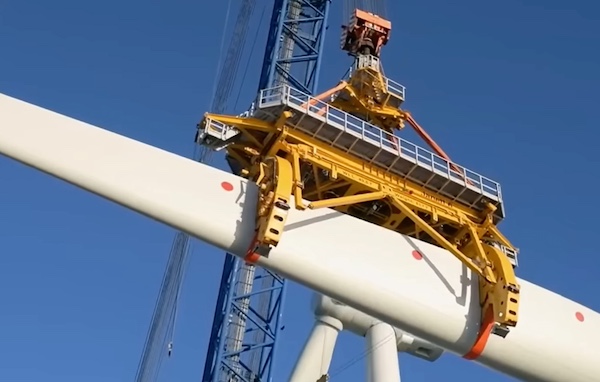
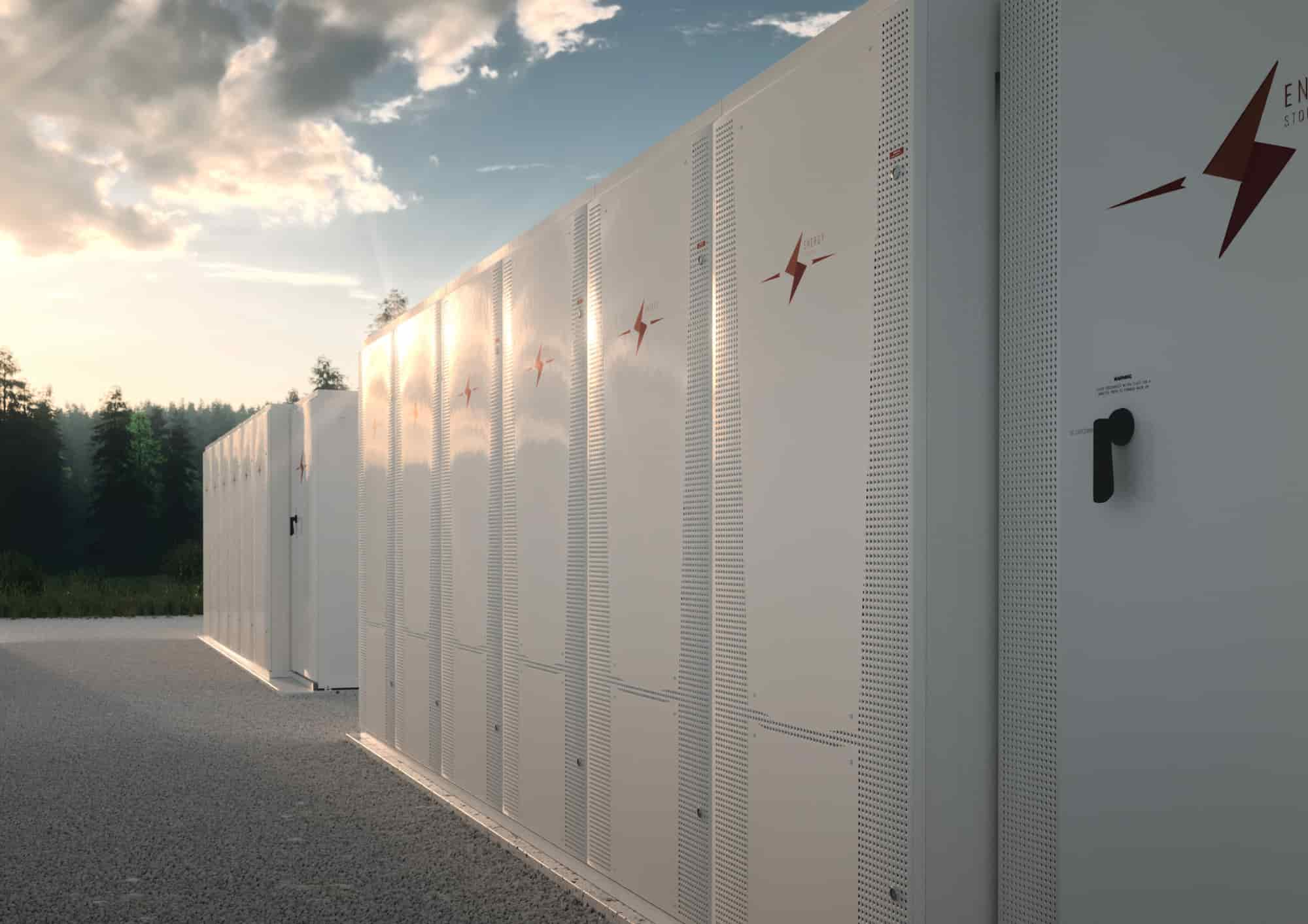
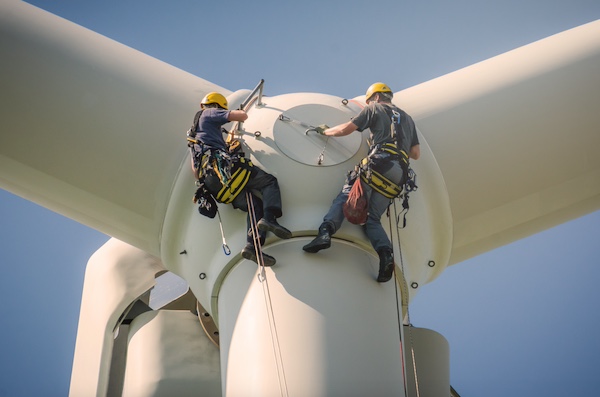
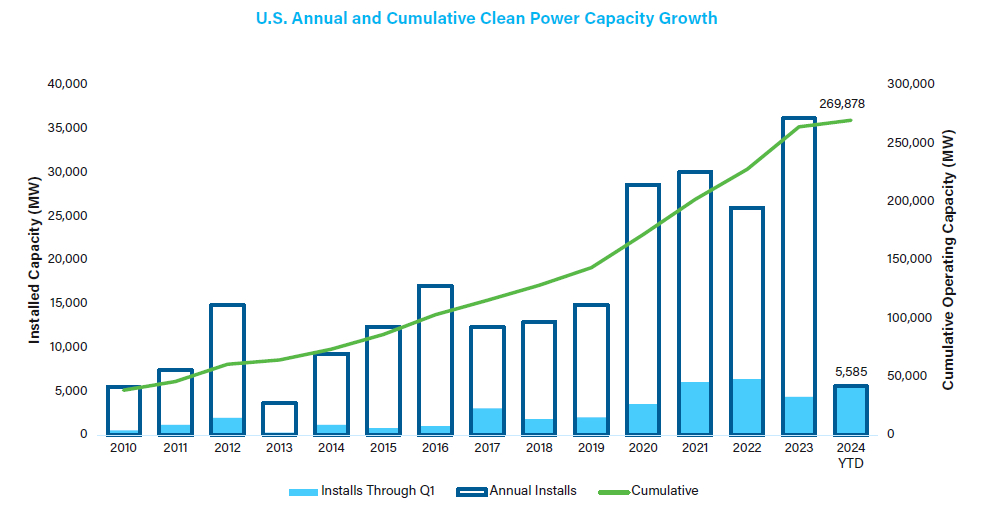
In an impressive start to the year, the American Clean Power Association (ACP) revealed that the U.S. utility-scale solar, wind, and storage sectors added a combined 5,585 megawatts (MW) of new capacity in the first quarter of 2024, marking an increase of 28% compared to installations in the same period a year ago. These additions are enough to power 1 million homes with clean energy.
ACP’s new Clean Power Quarterly Market Report | Q1 2024 finds the industry also reached significant milestones in the first quarter: utility-scale solar surpassed 100 gigawatts (GW) of installed capacity, and the first offshore wind project in federal waters began supplying 132 MW of clean, reliable power to the grid.
“The first quarter of 2024 set the pace for the year, underscoring both an industry that continues to break barriers and the increasing demand for clean energy solutions,” said John Hensley, ACP’s VP of Markets and Policy Analysis. “Crossing the 100 GW milestone for solar, launching groundbreaking projects like South Fork Wind, and a record-setting pace of new contracts for clean energy are clear indicators of the public’s demand to bolster the grid with domestic, reliable and affordable clean energy.”
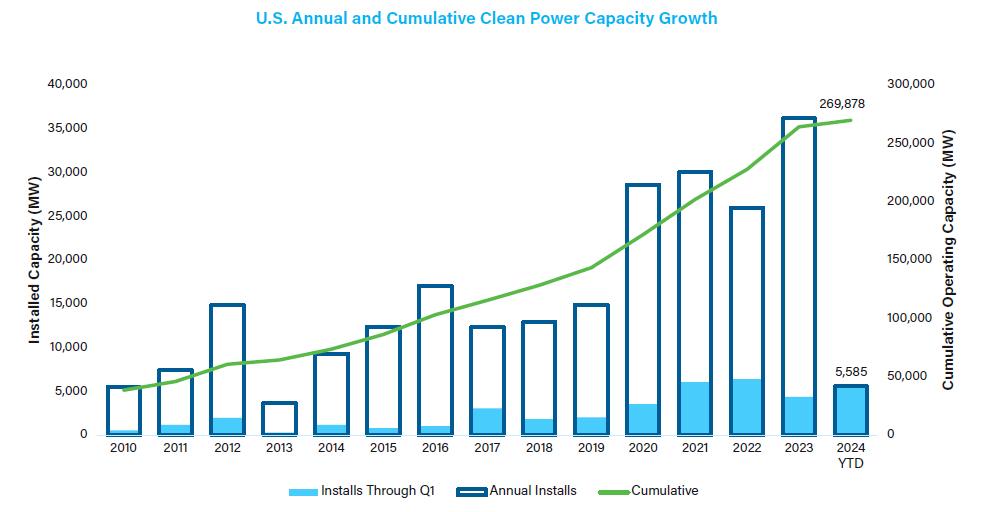
Key highlights from the Q1 2024 report include:
The clean energy future keeps getting brighter, with the clean power pipeline expanding to nearly 175 GW—the highest amount on record. The robust expansion of the pipeline can be attributed to battery storage and solar, which have grown at an average rate of 11% and 4% per quarter since the second quarter of 2022.
While energy storage deployments were flat compared to the same period in the previous year, the pipeline for new storage projects increased by 61% year-over-year to 31.6 GW in the near-term pipeline, indicating strong future growth.
The land-based wind market, despite a lackluster quarter, also saw its project pipeline expand, increasing 37% year-over-year to 13.7 GW. Wyoming and New Mexico are leading the charge for the technology, supplanting long-time market leader Texas.
U.S. clean power capacity now stands at 269,878 MW—enough to power more than 68 million American homes.
Read more about today’s clean energy industry trends in the Clean Power Quarterly Market Report | Q1 2024.

BAE Systems (LON: BA), a leader in electric propulsion, and Eaton, a global power management company, are expanding their collaboration to include electric vehicle (EV) solutions for heavy-duty trucks. The solution offers original equipment manufacturers and commercial vehicle modifiers a comprehensive, efficient, advanced, and flexible EV system for a wide range of zero-emission platforms.
In 2023, the two companies signed a memorandum of understanding to provide electric drive technology solutions for the medium-duty truck market. The expanded collaboration now includes heavy-duty applications, offering manufacturers a complete line of electric drive systems for commercial trucks above 19 tons.
BAE Systems will now combine its electric motor and suite of power dense, advanced power electronics with Eaton's HD 4-speed EV transmission to provide a full heavy-duty EV system. Along with the existing MD-4 solution, the integrated systems are designed for medium- and heavy-duty applications, including pick-up and delivery trucks, school and transit buses, and material handling, refuse, and regional haul trucks.
"We are combining our expertise and proven technology to provide customers with a complete EV solution," said Bob Lamanna, vice president and general manager of Power & Propulsion Solutions at BAE Systems.
"By expanding our scope to include more vehicle ratings, our robust system ensures high performance and reliability across a wider range of classes and sizes," said Mark Kramer, business unit director, ePowertrain, Eaton's Vehicle Group.
The BAE Systems and Eaton solution delivers proven technology in an integrated package that meets the demands of the commercial truck market, backed by decades of collective experience in vehicle electrification. BAE Systems' power electronics feature advanced materials and a compact, modular design that uses fewer parts, making it highly reliable and adaptable to diverse platforms. Eaton's MD and HD EV transmissions are purpose-built to increase range, grade capability, and acceleration for commercial electric vehicles.
BAE Systems | www.baesystems.com/US
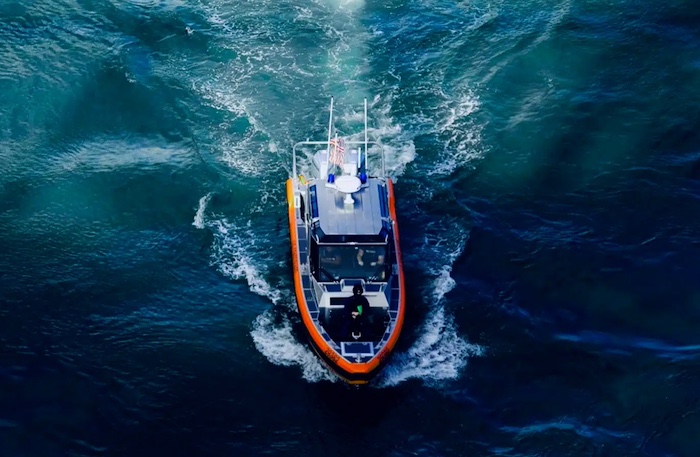
Echandia, the leading Swedish maritime battery system supplier, has received an order from Öresundslinjen for the conversion of M/S Hamlet from fossil fuel dependency to full electrical operation. The battery system is scheduled for delivery in the first half of 2025.
Operating on the Helsingør – Helsingborg route, M/S Hamlet traverses the Öresund strait up to 8000 times annually. The battery system is tailored for a minimum operational lifespan of 10 years without requiring battery replacement. Furthermore, the battery can be recharged in both ports in as little as 11 minutes on average.
"After evaluating multiple battery suppliers for this significant conversion project, the superior lifetime and lower weight of the Echandia battery system stood out as the primary reasons why Echandia emerged as the optimal choice for us," says Kristian Durhuus, CEO at Molslinjen. "These factors contribute to the lowest Total Cost of Ownership (TCO) and environmental footprint when compared to other options," Kristian Durhuus adds.
"This order once again demonstrates the recognition of Echandia's battery systems within the maritime market, particularly in Denmark. Following the successful deployment of harbour buses in Copenhagen in 2020 and securing the contract for Molslinjen's RoPax ferries for Als and Samsö in 2022, it is evident that Danish shipowners are increasingly valuing the advantages of Echandia when evaluating battery system options. We are honored to have been chosen by Öresundslinjen, a leader in maritime electrification, for this significant project," says Morten Larsen, Regional Director EU at Echandia.
Echandia | https://echandia.se/
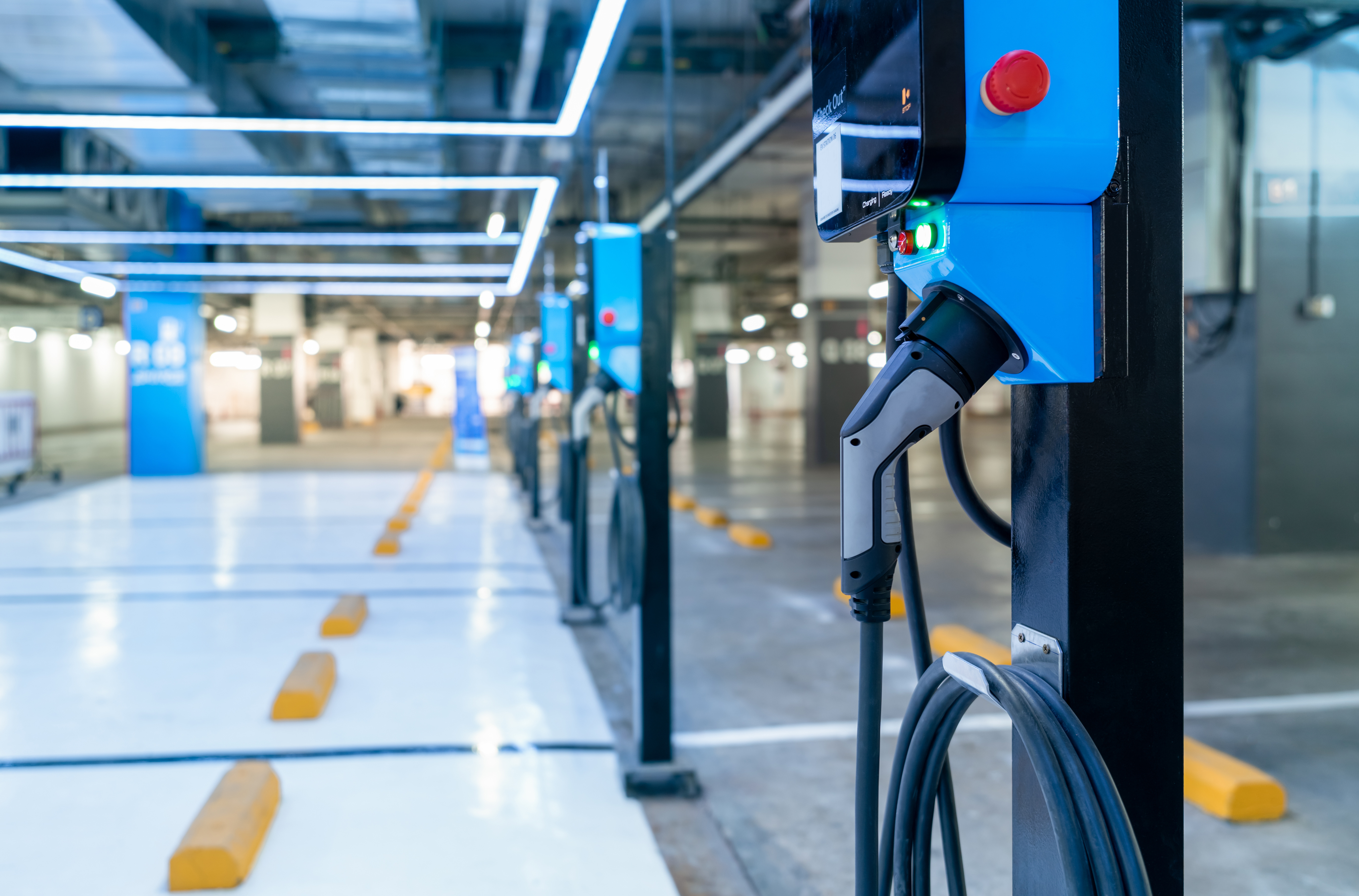
Addionics, a leader in battery technology and 3D current collector manufacturer, and IL Science, a front-runner in mobility and battery solutions, announced a partnership through a Memorandum of Understanding (MOU). This collaboration aims to advance lithium metal rechargeable batteries by integrating high-stability lithium metal with advanced next-generation copper current collectors. This strategic partnership is crucial for enhancing battery capabilities and addressing key challenges that have hindered their broader adoption.
Lithium metal batteries are advantageous due to their lightweight, high energy density, and fast-charging features, presenting a significant advancement over traditional lithium-ion batteries. Despite these benefits, safety, durability, and cost concerns have limited their widespread application. The synergy between Addionics' 3D Current Collectors™, which represent a groundbreaking approach to battery architecture, and IL Science's cutting-edge lithium coating and treatment technologies aspires to overcome these hurdles. By bolstering the performance, and marketability, of lithium-ion batteries with lithium-metal anodes this partnership represents a leap forward for battery technology.
The high-stability 3D lithium anode developed as part of the collaboration will contribute to the commercialization of high-performance, next-generation lithium rechargeable batteries and will create new opportunities for major battery manufacturers worldwide.
"This collaboration comes as the demand from battery manufacturers, and the auto industry, for lithium metal batteries is growing, so accelerating the development of 3D current collectors designed for these batteries is critical," said Dr. Moshiel Bitton, CEO and Co-Founder of Addionics. "Combining our expertise in battery technology innovation and growing manufacturing capabilities in the US with IL Science's experience in the mobility market, utilizing its mass production know-how and well-developed supply chain, will help us bring our new product, and high-performance lithium metal batteries, to the market as soon as possible."
"We are pleased to have Addionics as a partner in the development of next-generation lithium rechargeable batteries," said Sung-Geun Song, CEO of IL Science. "We believe that this collaboration will be the launching point for more innovative products for the battery market."
Addionics | www.addionics.com
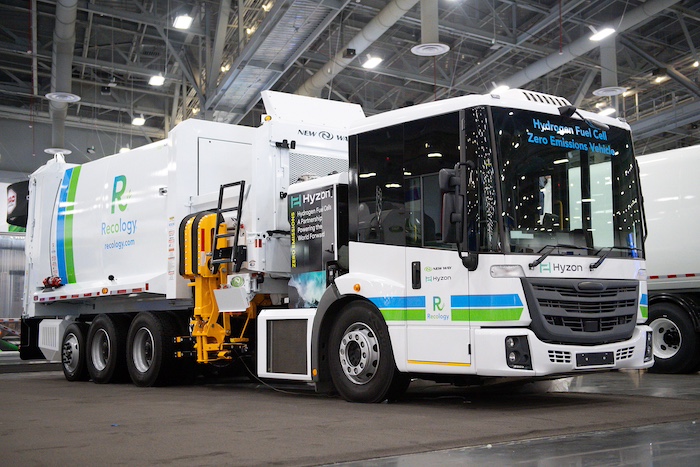
Hyzon (NASDAQ: HYZN), a U.S.-based, leading hydrogen fuel cell technology developer and global supplier of zero-emission powertrains and New Way Trucks, a privately held industry-leading refuse truck body manufacturer, are showcasing North America's first hydrogen fuel cell-powered electric refuse truck at Waste Expo, May 7-9 at the Las Vegas Convention Center.
This debut to the U.S. market follows February's announcement of the Joint Development Agreement (JDA) between New Way and Hyzon, combining both companies' expertise and industry leadership to develop a premier zero-emission refuse collection solution.
"Building on Hyzon's fuel cell electric refuse vehicle experience in Australia, Hyzon and New Way's strategic partnership assembled a historic vehicle to eliminate emissions within a hard-to-abate industry," said Hyzon Chief Executive Officer Parker Meeks. "This is evidence of our shared mission to provide North American refuse collection fleets with an alternative power solution that both meets zero emissions requirements and performs the hard work a refuse truck needs to deliver day in and day out."
Through this partnership, Hyzon and New Way have been able to make the hydrogen fuel cell electric refuse collection vehicle a reality for the North American waste and recycling industry.
"As a growing market leader with a long history in building high-performance refuse collection equipment, New Way is in a unique position to be able to bring this sustainable, alternative power solution to waste haulers looking to meet decarbonization objectives and other clean energy requirements," said New Way Chief Sales Officer Don Ross.
At Waste Expo, visitors to booth #1341 will see proof of the hydrogen-powered electric refuse collection vehicle concept. Hyzon's high-performance hydrogen fuel cells are tough enough to provide consistent power over 125 miles, including up to 1,200 cart lifts and trips to the transfer station. Combine that with the strength and durability of New Way's most-requested automated side loader – the Sidewinder XTR -- with smooth arm operation, up to a 12-foot reach and large 6-cubic-yard hopper for an unstoppable, sustainable refuse collection powerhouse. Another feature in the booth is a 200kw fuel cell display, along with an animation that showcases how hydrogen fuel cell technology works and a fact sheet on the New Way and Hyzon Fuel Cell Electric Vehicle (FCEV) and vehicle specifications.
Both New Way and Hyzon look forward to further technology and performance development with the Class 8 FCEV as more information is gathered during customer demonstrations occurring throughout the rest of 2024. After Waste Expo, the truck will test on routes in California starting with Recology, the San Francisco-based hauler. Recology is an employee-owned solid waste and recycling collection and processing company with a commitment to sustainable operations at its core.
Recology has long shown its commitment to sustainable transportation — the company recently achieved its goal to power its fleet with more than 90 percent renewable or alternative fuels — and now sees the demo of this first-of-its-kind hydrogen-powered truck as an opportunity to be on the forefront of helping decarbonize the industry.
"As a leader in fleet sustainability, we're proud to partner with New Way and Hyzon to bring the first hydrogen fuel cell electric collection vehicle to test in our communities in California," said Recology CEO Sal Coniglio. "Recology has been preparing to transition our fleet to zero emission vehicles for nearly six years, and we've yet to see a hydrogen fuel cell powered refuse truck on the market during that time. This development is a major milestone, and we're thrilled to be the first to demo this technology to help move our business and the industry forward."
Hyzon | www.hyzonfuelcell.com
New Way Trucks | www.newwaytrucks.com
Recology | https://www.recology.com/
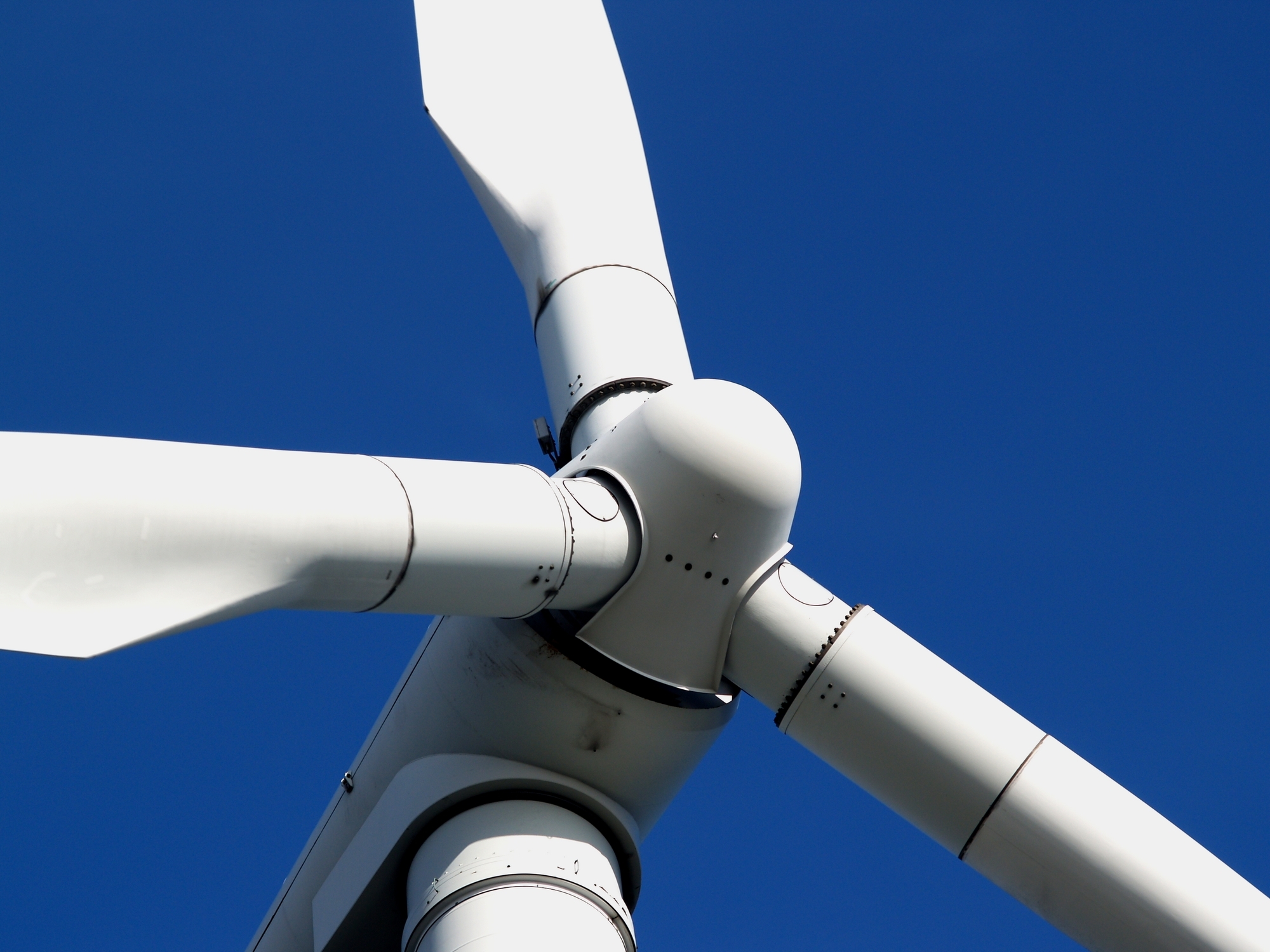
The Institute of Contemporary Art Miami (ICA) and a subsidiary of ENGIE North America (ENGIE) announced an innovative new collaboration that advances an emerging renewable energy solution and expands the museum's sustainability efforts. Under the terms of a five-year agreement with ENGIE Resources LLC, ICA Miami will procure Renewable Energy Certificates (RECs) from ENGIE's Priddy Wind Project (Mills County, Texas) to match 100% of the museum's forecast electricity consumption. As the first renewable energy agreement in Florida for ENGIE Resources, the collaboration represents increasing interest for similar solutions in markets that are not yet open to retail power competition.
A leading contemporary art museum in the U.S. and globally, ICA Miami is recognized for promoting continuous experimentation and embracing innovative practices, through its exhibitions and programs and in its operations and practices. In 2020, the museum was among the original grantees for the Helen Frankenthaler Foundation's sustainability funding and has since implemented carbon offsets and sustainable shipping practices for major exhibitions. With this energy agreement, ICA Miami is matching 100% of its electricity consumption for the building and museum operations with project-specific Green-e certified RECs that avoid the greenhouse gas emissions of 1,352 metric tons of CO2 equivalent.*
Commercial and industrial customers from any market can support sustainability efforts by sourcing project-specific RECs, but interest is in its early stages. "Customer understanding and adoption of RECs takes time," said Brad McIntyre, business development manager at ENGIE Resources. "ICA Miami is a great jumping-off point for us in the South Florida market," said McIntyre. "RECs provide sustainable solutions for developers to invest in new assets and we expect this agreement to accelerate the impact of renewables in this and other similar markets."
"ICA Miami has long been committed to adopting best practices for sustainability and reducing the museum's carbon footprint. Our alliance with ENGIE not only supports the museum's ongoing sustainability efforts, but also contributes to an emerging renewable energy solution that is not yet prevalent in South Florida. We are excited to be a part of bringing these kinds of solutions to our community and to continue expanding on this work," said Alex Gartenfeld, ICA Miami Irma and Norman Braman artistic director.
Acting as an advisor on the agreement is Industrial Energy (Fort Lauderdale, FL). "It is exciting to be at the forefront of a solution that promotes planet-friendly power in a market that is not yet open to retail choice," said Christian Amabile, executive vice president. It's a privilege to work with an organization that plays such an important role in the social landscape."
Green-e RECs are certified by the nonprofit Center for Resource Solutions. Certification ensures that RECs are properly accounted for and that no double counting takes place.
*EPA Greenhouse Gas Equivalencies Calculator
Institute of Contemporary Art, Miami | icamiami.org
ENGIE North America I https://www.engie-na.com/
Industrial Energy | industrialenergy.info
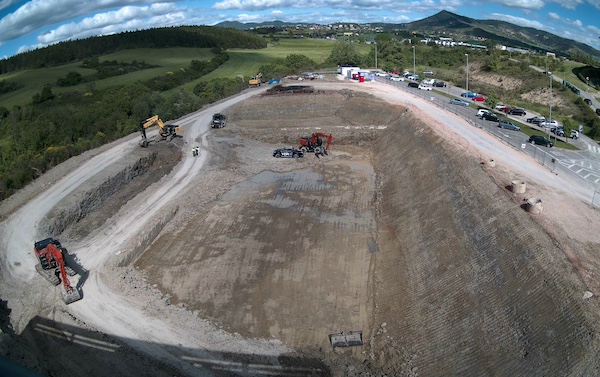
Ingeteam continues to invest in R&D and strengthen its Spanish national presence, where it currently employs almost 2,900 people. The company takes a further step forward with the construction of a new R&D laboratory, which will become a leading international benchmark in electrification and renewables, to be located beside the company's current offices in the Nothern city of Pamplona. Ingeteam currently has 8 laboratories in the Basque Country and Navarre, where it tests its new developments in the field of rotating electrical machines and power and control electronics, including a recently incorporated 4.0 laboratory.
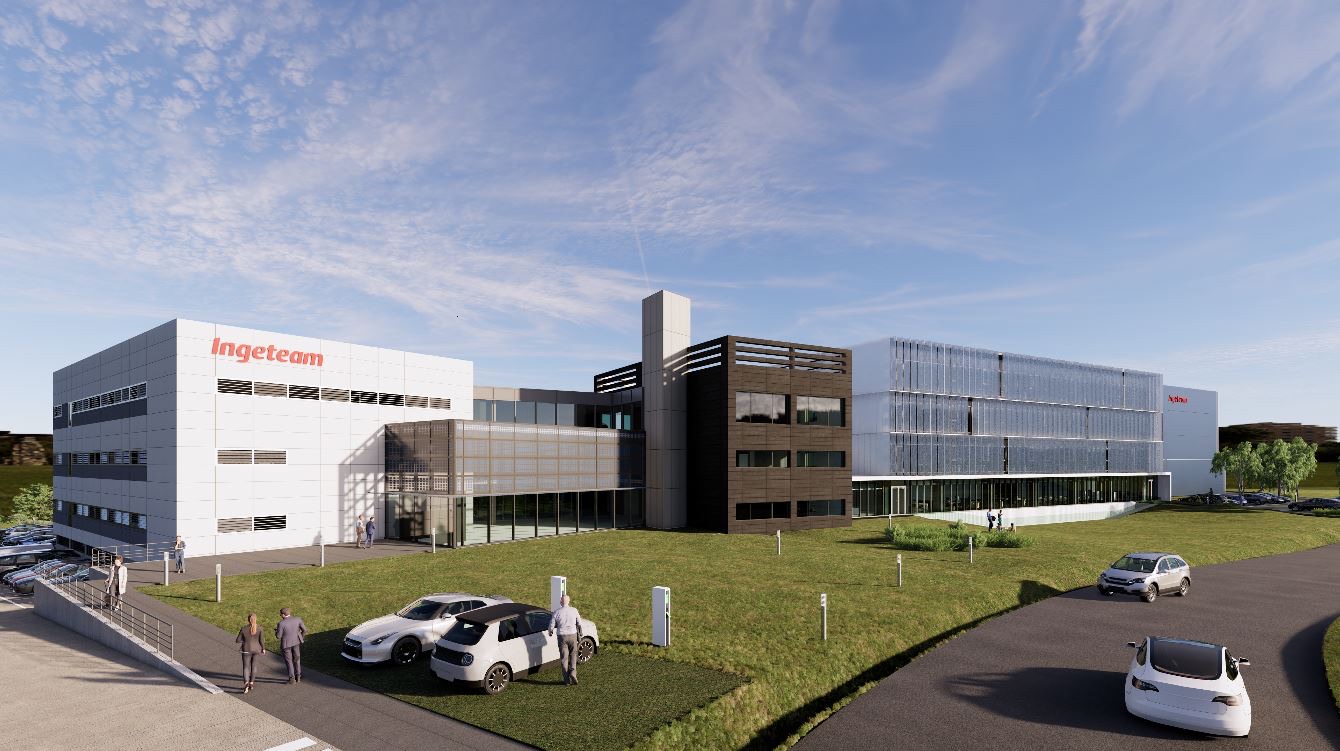
The construction of the new building, which will add a further 12,000 sqm of floor space to the existing facilities, between the laboratory, offices and ancillary areas, will require an investment of about €25M. In addition to housing the new laboratory, the facility will provide the company with new office space for over 250 people, to support the significant growth in staff it has experienced in recent years.
At the beginning of 2022, Ingeteam announced a new strategic plan with a total investment of €210M for its R&D activities and new infrastructures, including this new laboratory, which is expected to be operational by the end of 2025.
Partial tests, validations, type tests and combined power and control electronics tests of the systems designed and manufactured by Ingeteam will be conducted at the new facilities. The main application sectors are currently wind and solar power, electric car chargers, battery energy storage and green hydrogen. Sectors that all pursue the electrification of society as the only means to achieve the decarbonisation of the economy and contribute to sustainable development, fighting against climate change. Ingeteam thus invests in technology and the future, creating wealth and quality employment in the region, with a project that is 100% in line with the company's identity.
Technological innovation, a key factor for Ingeteam's activity, is the driving force behind its growth and evolution. Ingeteam invests around 5% of its annual turnover in R&D and employs over 500 people dedicated to research and development. Having such a facility will put the company in an excellent position to further pursue its aim of electrifying a sustainable future.
Ingeteam | https://www.ingeteam.com/en-us/home.aspx
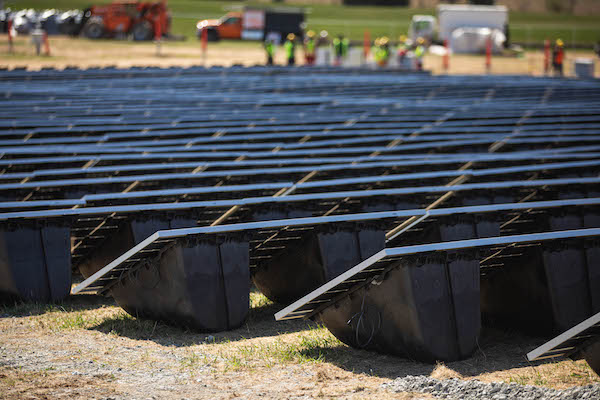
Alternative Energies May 15, 2023
The United States is slow to anger, but relentlessly seeks victory once it enters a struggle, throwing all its resources into the conflict. “When we go to war, we should have a purpose that our people understand and support,” as former Secretary ....
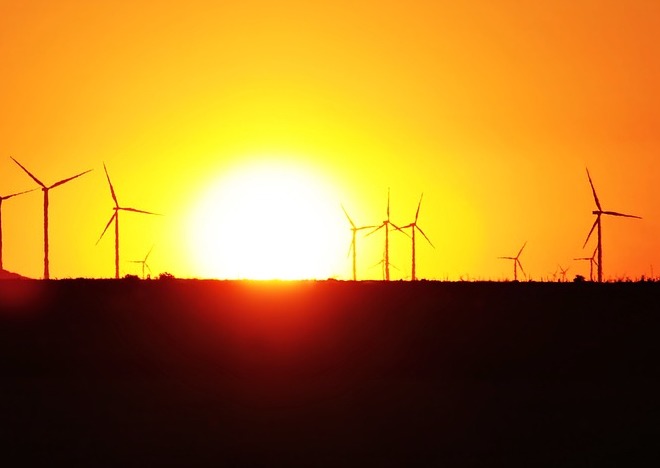
Unleashing trillions of dollars for a resilient energy future is within our grasp — if we can successfully navigate investment risk and project uncertainties.
The money is there — so where are the projects?
A cleaner and more secure energy future will depend on tapping trillions of dollars of capital. The need to mobilize money and markets to enable the energy transition was one of the key findings of one of the largest studies ever conducted among the global energy sector C-suite. This will mean finding ways to reduce the barriers and uncertainties that prevent money from flowing into the projects and technologies that will transform the energy system. It will also mean fostering greater collaboration and alignment among key players in the energy space.
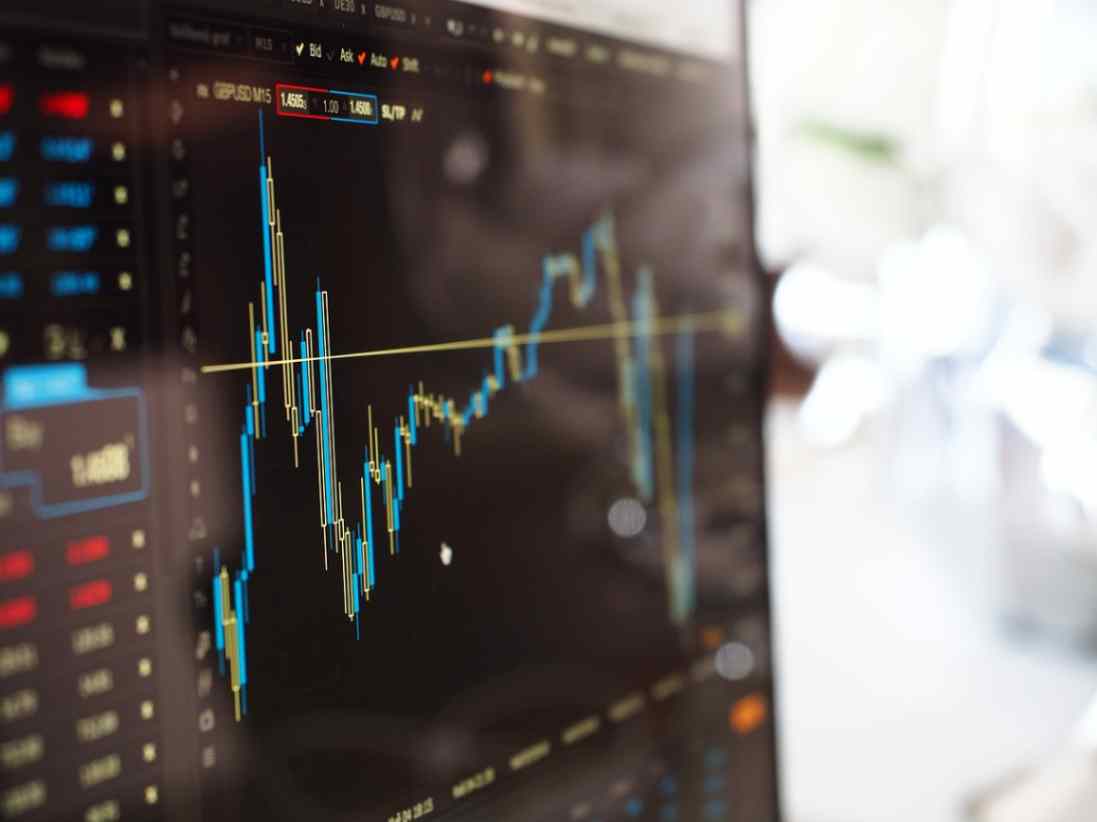 Interestingly, the study found that insufficient access to finance was not considered the primary cause of the current global energy crisis. In fact, capital was seen to be available — but not being unlocked. Why is that? The answer lies in the differing risk profiles of energy transition investments around the world. These risks manifest in multiple ways, including uncertainties relating to project planning, public education, stakeholder engagement, permitting, approvals, policy at national and local levels, funding and incentives, technology availability, and supply chains.
Interestingly, the study found that insufficient access to finance was not considered the primary cause of the current global energy crisis. In fact, capital was seen to be available — but not being unlocked. Why is that? The answer lies in the differing risk profiles of energy transition investments around the world. These risks manifest in multiple ways, including uncertainties relating to project planning, public education, stakeholder engagement, permitting, approvals, policy at national and local levels, funding and incentives, technology availability, and supply chains.
These risks need to be addressed to create more appealing investment opportunities for both public and private sector funders. This will require smart policy and regulatory frameworks that drive returns from long-term investment into energy infrastructure. It will also require investors to recognize that resilient energy infrastructure is more than an ESG play — it is a smart investment in the context of doing business in the 21st century.
Make de-risking investment profiles a number one priority
According to the study, 80 percent of respondents believe the lack of capital being deployed to accelerate the transition is the primary barrier to building the infrastructure required to improve energy security. At the same time, investors are looking for opportunities to invest in infrastructure that meets ESG and sustainability criteria. This suggests an imbalance between the supply and demand of capital for energy transition projects.
How can we close the gap?
One way is to link investors directly to energy companies. Not only would this enable true collaboration and non-traditional partnerships, but it would change the way project financing is conceived and structured — ultimately aiding in potentially satisfying the risk appetite of latent but hugely influential investors, such as pension funds. The current mismatch of investor appetite and investable projects reveals a need for improving risk profiles, as well as a mindset shift towards how we bring investment and developer stakeholders together for mutual benefit. The circular dilemma remains: one sector is looking for capital to undertake projects within their skill to deploy, while another sector wonders where the investable projects are.
This conflict is being played out around the world; promising project announcements are made, only to be followed by slow progress (or no action at all). This inertia results when risks are compounded and poorly understood. To encourage collaboration between project developers and investors with an ESG focus, more attractive investment opportunities can be created by pulling several levers: public and private investment strategies, green bonds and other sustainable finance instruments, and innovative financing models such as impact investing.
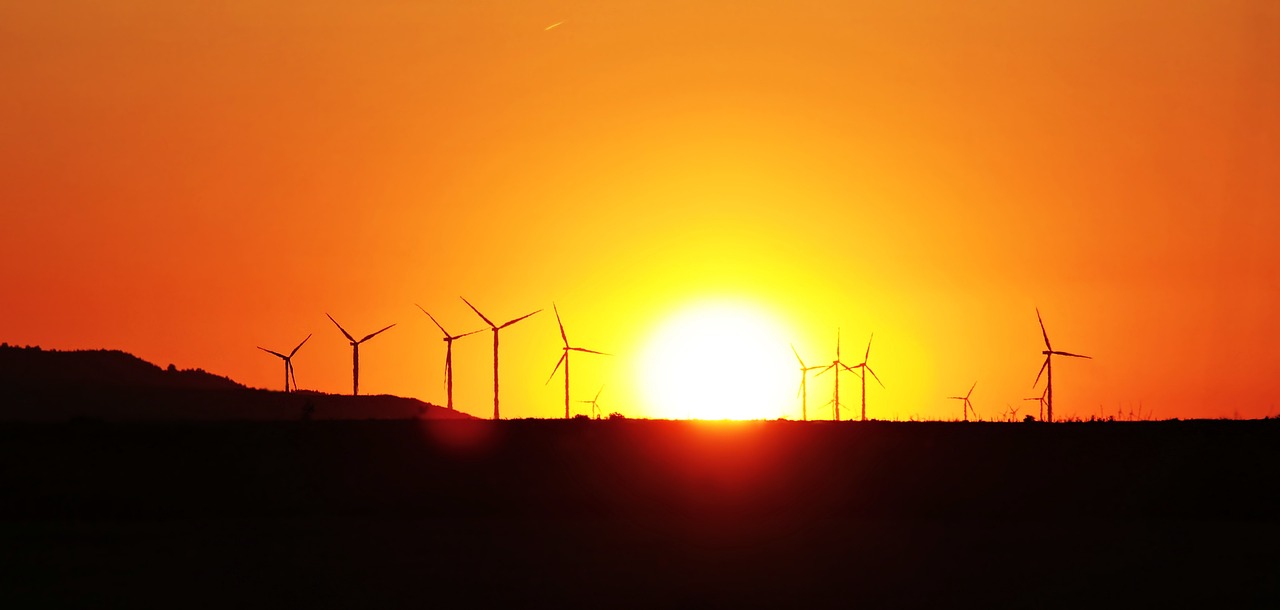
Expedite permitting to speed the adoption of new technologies
Another effective strategy to de-risk investment profiles is found in leveraging new technologies and approaches that reduce costs, increase efficiency, and enhance the reliability of energy supply. Research shows that 62 percent of respondents indicated a moderate or significant increase in investment in new and transitional technologies respectively, highlighting the growing interest in innovative solutions to drive the energy transition forward.
Hydrogen, carbon capture and storage, large-scale energy storage, and smart grids are some of the emerging technologies identified by survey respondents as having the greatest potential to transform the energy system and create new investment opportunities. However, these technologies face challenges such as long lag times between conception and implementation.
If the regulatory environment makes sense, then policy uncertainty is reduced, and the all-important permitting pathways are well understood and can be navigated. Currently, the lack of clear, timely, and fit-for-purpose permitting is a major roadblock to the energy transition. To truly unleash the potential of transitional technologies requires the acceleration of regulatory systems that better respond to the nuance and complexity of such technologies (rather than the current one-size-fits all approach). In addition, permitting processes must also be expedited to dramatically decrease the period between innovation, commercialization, and implementation. One of the key elements of faster permitting is effective consultation with stakeholders and engagement with communities where these projects will be housed for decades. This is a highly complex area that requires both technical and communication skills.
The power of collaboration, consistency, and systems thinking
The report also reveals the need for greater collaboration among companies in the energy space to build a more resilient system. The report shows that, in achieving net zero, there is a near-equal split between those increasing investment (47 percent of respondents), and those decreasing investment (39 percent of respondents). This illustrates the complexity and diversity of the system around the world. A more resilient system will require all its components – goals and actions – to be aligned towards a common outcome.
Another way to de-risk the energy transition is to establish consistent, transparent, and supportive policy frameworks that encourage investment and drive technological innovation. The energy transition depends on policy to guide its direction and speed by affecting how investors feel and how the markets behave. However, inconsistent or inadequate policy can also be a source of uncertainty and instability. For example, shifting political priorities, conflicting international standards, and the lack of market-based mechanisms can hinder the deployment of sustainable technologies, resulting in a reluctance to commit resources to long-term projects.
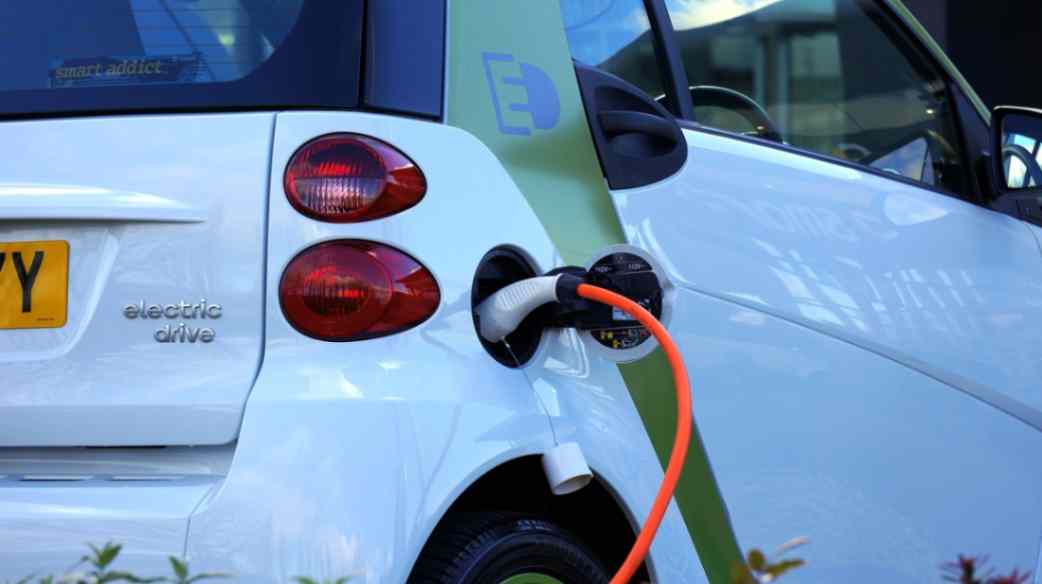
Variations in country-to-country deployment creates disparities in energy transition progress. For instance, the 2022 Inflation Reduction Act in the US has posed challenges for the rest of the world, by potentially channeling energy transition investment away from other markets and into the US. This highlights the need for a globally unified approach to energy policy that balances various national interests while addressing a global problem.
To facilitate the energy transition, it is imperative to establish stable, cohesive, and forward-looking policies that align with global goals and standards. By harmonizing international standards, and providing clear and consistent signals, governments and policymakers can generate investor confidence, helping to foster a robust energy ecosystem that propels the sector forward.
Furthermore, substantive and far-reaching discussions at international events like the United Nations Conference of the Parties (COP), are essential to facilitate this global alignment. These events provide an opportunity to de-risk the energy transition through consistent policy that enables countries to work together, ensuring that the global community can tackle the challenges and opportunities of the energy transition as a united front.
Keeping net-zero ambitions on track
Despite the challenges faced by the energy sector, the latest research reveals a key positive: 91 percent of energy leaders surveyed are working towards achieving net zero. This demonstrates a strong commitment to the transition and clear recognition of its importance. It also emphasizes the need to accelerate our efforts, streamline processes, and reduce barriers to realizing net-zero ambitions — and further underscores the need to de-risk energy transition investment by removing uncertainties.
The solution is collaborating and harmonizing our goals with the main players in the energy sector across the private and public sectors, while establishing consistent, transparent, and supportive policy frameworks that encourage investment and drive technological innovation.
These tasks, while daunting, are achievable. They require vision, leadership, and action from all stakeholders involved. By adopting a new mindset about how we participate in the energy system and what our obligations are, we can stimulate the rapid progress needed on the road to net zero.
Dr. Tej Gidda (Ph.D., M.Sc., BSc Eng) is an educator and engineer with over 20 years of experience in the energy and environmental fields. As GHD Global Leader – Future Energy, Tej is passionate about moving society along the path towards a future of secure, reliable, and affordable low-carbon energy. His focus is on helping public and private sector clients set and deliver on decarbonization goals in order to achieve long-lasting positive change for customers, communities, and the climate. Tej enjoys fostering the next generation of clean energy champions as an Adjunct Professor at the University of Waterloo Department of Civil and Environmental Engineering.
GHD | www.ghd.com
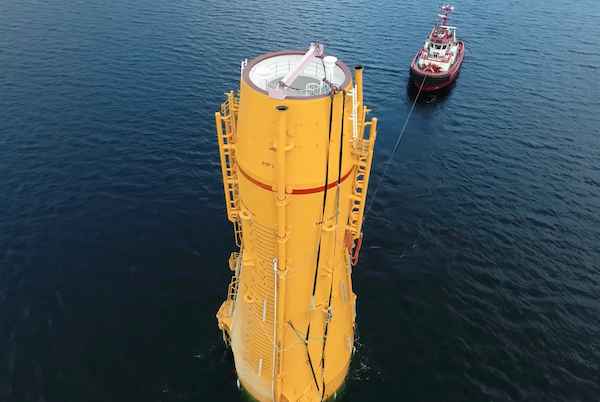
The Kincardine floating wind farm, located off the east coast of Scotland, was a landmark development: the first commercial-scale project of its kind in the UK sector. Therefore, it has been closely watched by the industry throughout its installation. With two of the turbines now having gone through heavy maintenance, it has also provided valuable lessons into the O&M processes of floating wind projects.
In late May, the second floating wind turbine from the five-turbine development arrived in the port of Massvlakte, Rotterdam, for maintenance. An Anchor Handling Tug Supply (AHTS)
vessel was used to deliver the KIN-02 turbine two weeks after a Platform Supply Vessel (PSV) and AHTS had worked to disconnect the turbine from the wind farm site. The towing vessel became the third vessel used in the operation.
This is not the first turbine disconnected from the site and towed for maintenance. In the summer of 2022, KIN-03 became the world’s first-ever floating wind turbine that required heavy maintenance (i.e. being disconnected and towed for repair). It was also towed from Scotland to Massvlakte.
Each of these operations has provided valuable lessons for the ever-watchful industry in how to navigate the complexities of heavy maintenance in floating wind as the market segment grows.

The heavy maintenance process
When one of Kincardine’s five floating 9.5 MW turbines (KIN-03) suffered a technical failure in May 2022, a major technical component needed to be replaced. The heavy maintenance strategy selected by the developer and the offshore contractors consisted in disconnecting and towing the turbine and its floater to Rotterdam for maintenance, followed by a return tow and re-connection. All of the infrastructure, such as crane and tower access, remained at the quay following the construction phase. (Note, the following analysis only covers KIN-03, as details of the second turbine operation are not yet available).
Comparing the net vessel days for both the maintenance and the installation campaigns at this project highlights how using a dedicated marine spread can positively impact operations.
For this first-ever operation, a total of 17.2 net vessel days were required during turbine reconnection—only a slight increase on the 14.6 net vessel days that were required for the first hook-up operation performed during the initial installation in 2021. However, it exceeds the average of eight net vessel days during installation. The marine spread used in the heavy maintenance operation differed from that used during installation. Due to this, it did not benefit from the learning curve and experience gained throughout the initial installation, which ultimately led to the lower average vessel days.
The array cable re-connection operation encountered a similar effect. The process was performed by one AHTS that spent 10 net vessel days on the operation. This compares to the installation campaign, where the array cable second-end pull-in lasted a maximum of 23.7 hours using a cable layer.
Overall, the turbine shutdown duration can be broken up as 14 days at the quay for maintenance, 52 days from turbine disconnection to turbine reconnection, and 94 days from disconnection to the end of post-reconnection activities.
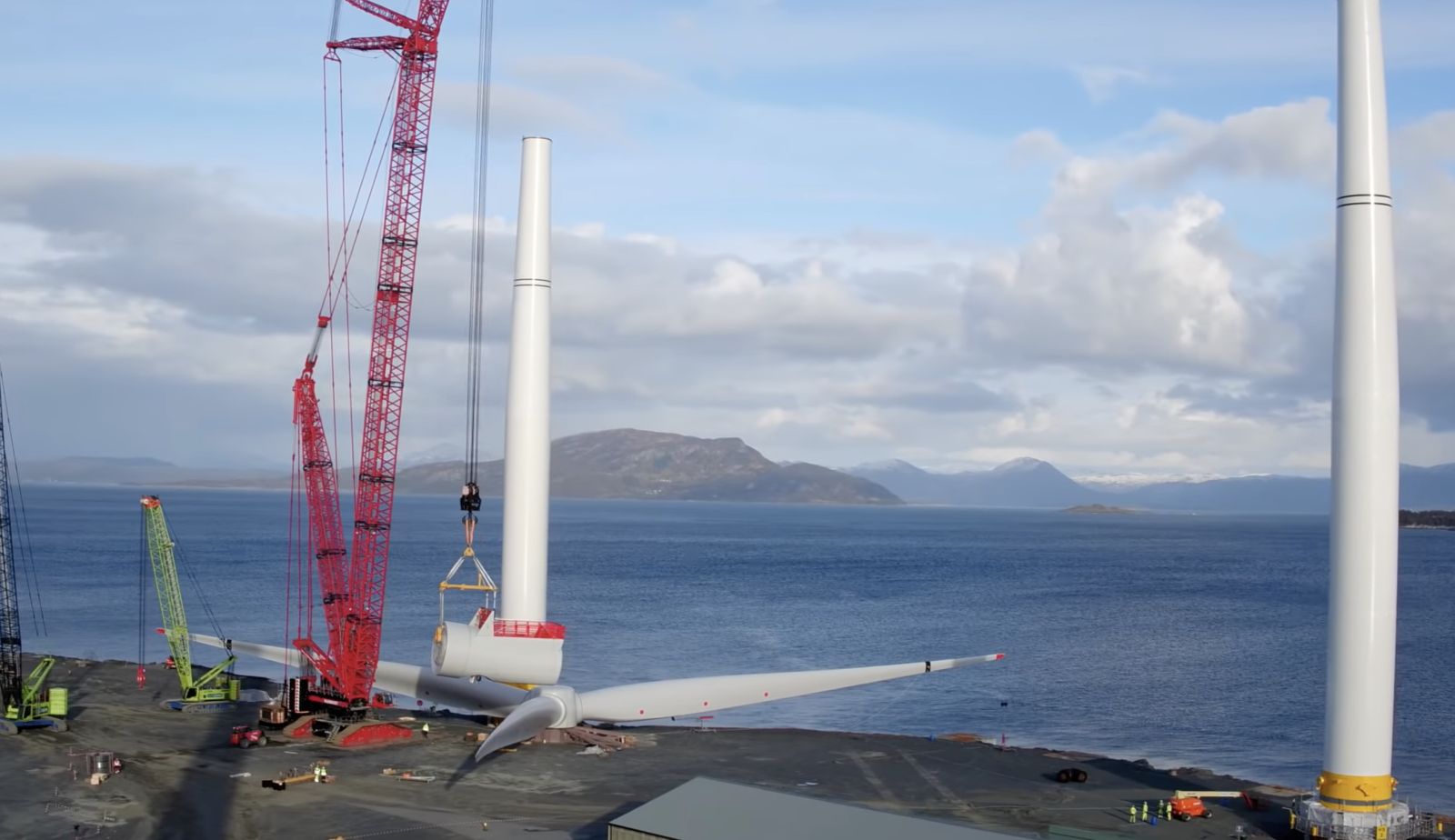
What developers should keep in mind for heavy maintenance operations
This analysis has uncovered two main lessons developers should consider when planning a floating wind project: the need to identify an appropriate O&M port, and to guarantee that a secure fleet is available.
Floating wind O&M operations require a port with both sufficient room and a deep-water quay. The port must also be equipped with a heavy crane with sufficient tip height to accommodate large floaters and reach turbine elevation. Distance to the wind farm should also be taken into account, as shorter distances will reduce towing time and, therefore, minimize transit and non-productive turbine time.
During the heavy maintenance period for KIN-03 and KIN-02, the selected quay (which had also been utilized in the initial installation phase of the wind farm project), was already busy as a marshalling area for other North Sea projects. This complicated the schedule significantly, as the availability of the quay and its facilities had to be navigated alongside these other projects. This highlights the importance of abundant quay availability both for installation (long-term planning) and maintenance that may be needed on short notice.
At the time of the first turbine’s maintenance program (June 2022), the North Sea AHTS market was in an exceptional situation: the largest bollard pull AHTS units contracted at over $200,000 a day, the highest rate in over a decade.
During this time, the spot market was close to selling out due to medium-term commitments, alongside the demand for high bollard pull vessels for the installation phase at a Norwegian floating wind farm project. The Norwegian project required the use of four AHTS above a 200t bollard pull. With spot rates ranging from $63,000 to $210,000 for the vessels contracted for Kincardine’s maintenance, the total cost of the marine spread used in the first repair campaign was more than $4 million.
Developers should therefore consider the need to structure maintenance contracts with AHTS companies, either through frame agreements or long-term charters, to decrease their exposure to spot market day rates as the market tightens in the future.

While these lessons are relevant for floating wind developers now, new players are looking towards alternative heavy O&M maintenance options for the future. Two crane concepts are especially relevant in this instance. The first method is for a crane to be included in the turbine nacelle to be able to directly lift the component which requires repair from the floater, as is currently seen on onshore turbines. This method is already employed in onshore turbines and could be applicable for offshore. The second method is self-elevating cranes with several such solutions already in development.
The heavy maintenance operations conducted on floating turbines at the Kincardine wind farm have provided invaluable insights for industry players, especially developers. The complex process of disconnecting and towing turbines for repairs highlights the need for meticulous planning and exploration of alternative maintenance strategies, some of which are already in the pipeline. As the industry evolves, careful consideration of ports, and securing fleet contracts, will be crucial in driving efficient and cost-effective O&M practices for the floating wind market.
Sarah McLean is Market Research Analyst at Spinergie, a maritime technology company specializing in emission, vessel performance, and operation optimization.
Spinergie | www.spinergie.com
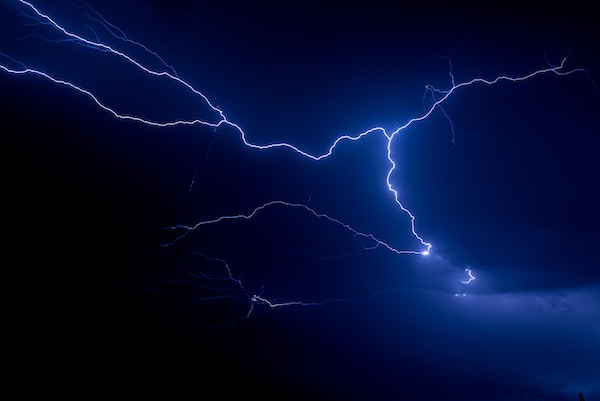
According to the Energy Information Administration (EIA), developers plan to add 54.5 gigawatts (GW) of new utility-scale electric generating capacity to the U.S. power grid in 2023. More than half of this capacity will be solar. Wind power and battery storage are expected to account for roughly 11 percent and 17 percent, respectively.
A large percentage of new installations are being developed in areas that are prone to extreme weather events and natural disasters (e.g., Texas and California), including high wind, tornadoes, hail, flooding, earthquakes, wildfires, etc. With the frequency and severity of many of these events increasing, project developers, asset owners, and tax equity partners are under growing pressure to better understand and mitigate risk.
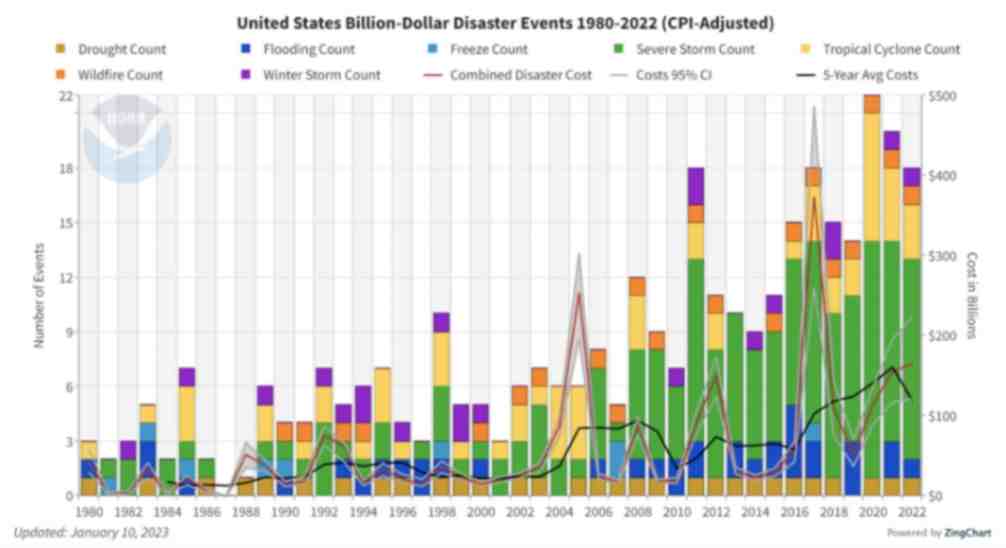
Figure 1. The history of billion-dollar disasters in the United States each year from 1980 to 2022 (source: NOAA)
In terms of loss prevention, a Catastrophe (CAT) Modeling Study is the first step to understanding the exposure and potential financial loss from natural hazards or extreme weather events. CAT studies form the foundation for wider risk management strategies, and have significant implications for insurance costs and coverage.
Despite their importance, developers often view these studies as little more than a formality required for project financing. As a result, they are often conducted late in the development cycle, typically after a site has been selected. However, a strong case can be made for engaging early with an independent third party to perform a more rigorous site-specific technical assessment. Doing so can provide several advantages over traditional assessments conducted by insurance brokerage affiliates, who may not possess the specialty expertise or technical understanding needed to properly apply models or interpret the results they generate. One notable advantage of early-stage catastrophe studies is to help ensure that the range of insurance costs, which can vary from year to year with market forces, are adequately incorporated into the project financial projections.
The evolving threat of natural disasters
Over the past decade, the financial impact of natural hazard events globally has been almost three trillion dollars. In the U.S. alone, the 10-year average annual cost of natural disaster events exceeding $1 billion increased more than fourfold between the 1980s ($18.4 billion) and the 2010s ($84.5 billion).

Investors, insurers, and financiers of renewable projects have taken notice of this trend, and are subsequently adapting their behavior and standards accordingly. In the solar market, for example, insurance premiums increased roughly four-fold from 2019 to 2021. The impetus for this increase can largely be traced back to a severe storm in Texas in 2019, which resulted in an $80 million loss on 13,000 solar panels that were damaged by hail.
The event awakened the industry to the hazards severe storms present, particularly when it comes to large-scale solar arrays. Since then, the impact of convective weather on existing and planned installations has been more thoroughly evaluated during the underwriting process. However, far less attention has been given to the potential for other natural disasters; events like floods and earthquakes have not yet resulted in large losses and/or claims on renewable projects (including wind farms). The extraordinary and widespread effect of the recent Canadian wildfires may alter this behavior moving forward.
A thorough assessment, starting with a CAT study, is key to quantifying the probability of their occurrence — and estimating potential losses — so that appropriate measures can be taken to mitigate risk.
All models are not created equal
Industrywide, certain misconceptions persist around the use of CAT models to estimate losses from an extreme weather event or natural disaster.
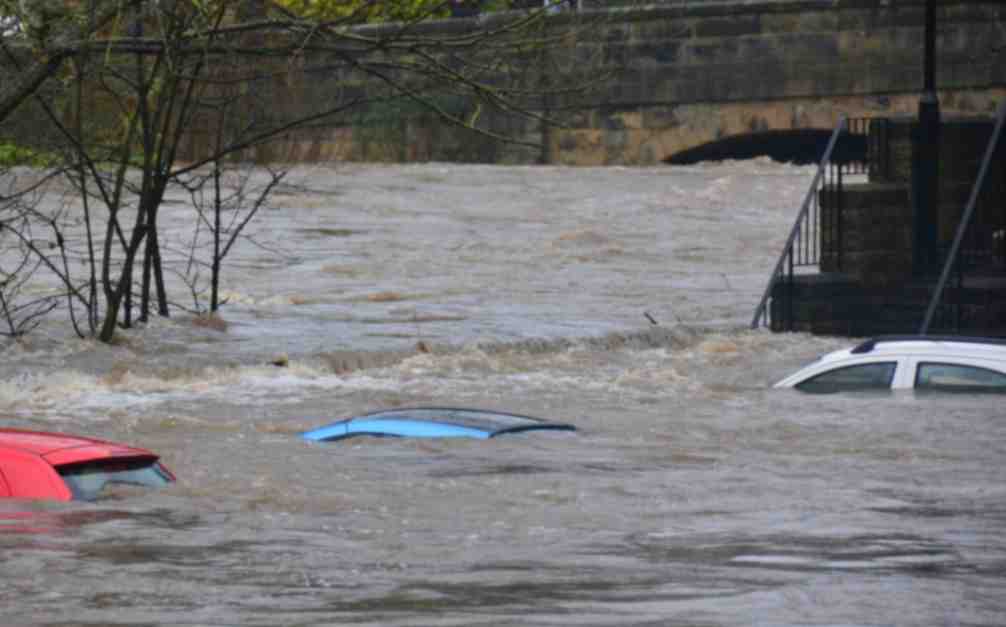
Often, the perception is that risk assessors only need a handful of model inputs to arrive at an accurate figure, with the geographic location being the most important variable. While it’s true that many practitioners running models will pre-specify certain project characteristics regardless of the asset’s design (for example, the use of steel moment frames without trackers for all solar arrays in a given region or state), failure to account for even minor details can lead to loss estimates that are off by multiple orders of magnitude.
The evaluation process has recently become even more complex with the addition of battery energy storage. Relative to standalone solar and wind farms, very little real-world experience and data on the impact of extreme weather events has been accrued on these large-scale storage installations. Such projects require an even greater level of granularity to help ensure that all risks are identified and addressed.
Even when the most advanced modeling software tools are used (which allow for thousands of lines of inputs), there is still a great deal that is subject to interpretation. If the practitioner does not possess the expertise or technical ability needed to understand the model, the margin for error can increase substantially. Ultimately, this can lead to overpaying for insurance. Worse, you may end up with a policy with insufficient coverage. In both cases, the profitability of the asset is impacted.
Supplementing CAT studies
In certain instances, it may be necessary to supplement CAT models with an even more detailed analysis of the individual property, equipment, policies, and procedures. In this way, an unbundled risk assessment can be developed that is tailored to the project. Supplemental information (site-specific wind speed studies and hydrological studies, structural assessment, flood maps, etc.) can be considered to adjust vulnerability models.
This provides an added layer of assurance that goes beyond the pre-defined asset descriptions in the software used by traditional studies or assessments. By leveraging expert elicitations, onsite investigations, and rigorous engineering-based methods, it is possible to discretely evaluate asset-specific components as part of the typical financial loss estimate study: this includes Normal Expected Loss (NEL), also known as Scenario Expected Loss (SEL); Probable Maximum Loss (PML), also known as Scenario Upper Loss (SUL); and Probabilistic Loss (PL).
Understanding the specific vulnerabilities and consequences can afford project stakeholders unique insights into quantifying and prioritizing risks, as well as identifying proper mitigation recommendations.
Every project is unique
The increasing frequency and severity of natural disasters and extreme weather events globally is placing an added burden on the renewable industry, especially when it comes to project risk assessment and mitigation. Insurers have signaled that insurance may no longer be the main basis for transferring risk; traditional risk management, as well as site and technology selection, must be considered by developers, purchasers, and financiers.
As one of the first steps in understanding exposure and the potential capital loss from a given event, CAT studies are becoming an increasingly important piece of the risk management puzzle. Developers should treat them as such by engaging early in the project lifecycle with an independent third-party practitioner with the specialty knowledge, tools, and expertise to properly interpret models and quantify risk.
Hazards and potential losses can vary significantly depending on the project design and the specific location. Every asset should be evaluated rigorously and thoroughly to minimize the margin for error, and maximize profitability over its life.
 Chris LeBoeuf is Global Head of the Extreme Loads and Structural Risk division of ABS Group, based in San Antonio, Texas. He leads a team of more than 60 engineers and scientists in the US, UK, and Singapore, specializing in management of risks to structures and equipment related to extreme loading events, including wind, flood, seismic and blast. Chris has more than 20 years of professional experience as an engineering consultant, and is a recognized expert in the study of blast effects and blast analysis, as well as design of buildings. He holds a Bachelor of Science in Civil Engineering from The University of Texas at San Antonio, and is a registered Professional Engineer in 12 states.
Chris LeBoeuf is Global Head of the Extreme Loads and Structural Risk division of ABS Group, based in San Antonio, Texas. He leads a team of more than 60 engineers and scientists in the US, UK, and Singapore, specializing in management of risks to structures and equipment related to extreme loading events, including wind, flood, seismic and blast. Chris has more than 20 years of professional experience as an engineering consultant, and is a recognized expert in the study of blast effects and blast analysis, as well as design of buildings. He holds a Bachelor of Science in Civil Engineering from The University of Texas at San Antonio, and is a registered Professional Engineer in 12 states.
ABS Group | www.abs-group.com
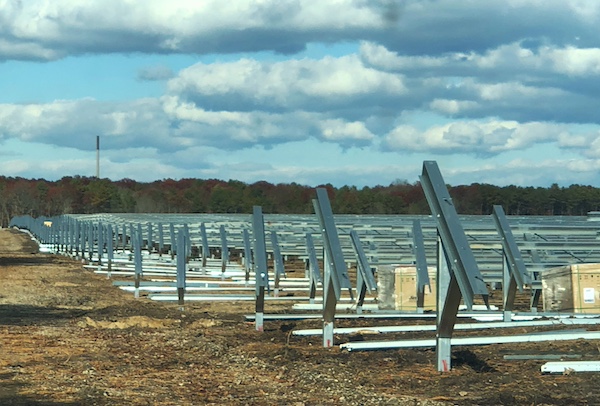
Throughout my life and career as a real estate developer in New York City, I’ve had many successes. In what is clearly one of my most unusual development projects in a long career filled with them, I initiated the building of a solar farm to help t....

I’m just going to say it, BIPV is dumb. Hear me out…. Solar is the most affordable form of energy that has ever existed on the planet, but only because the industry has been working towards it for the past 15 years. Governments,....
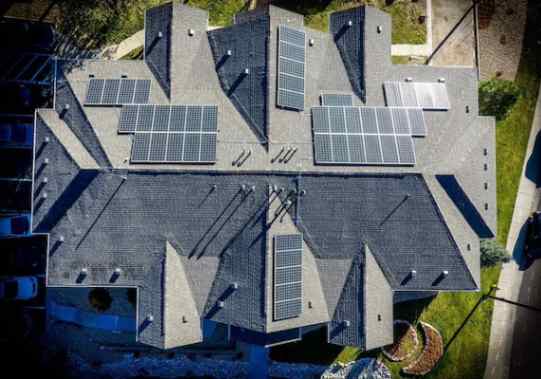
Heat waves encircled much of the earth last year, pushing temperatures to their highest in recorded history. The water around Florida was “hot-tub hot” — topping 101° and bleaching and killing coral in waters around the peninsula. Phoenix had ....
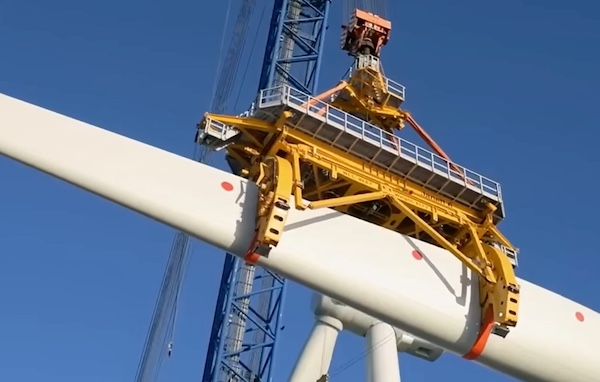
Wind turbines play a pivotal role in the global transition to sustainable energy sources. However, the harsh environmental conditions in which wind turbines operate, such as extreme temperatures, high humidity, and exposure to various contaminants, p....
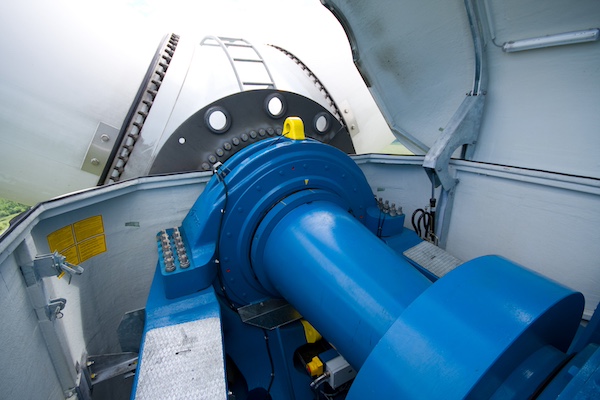
Wind energy remains the leading non-hydro renewable technology, and one of the fastest-growing of all power generation technologies. The key to making wind even more competitive is maximizing energy production and efficiently maintaining the assets. ....
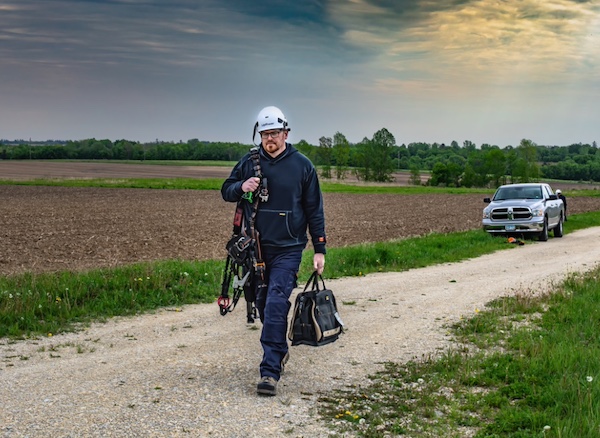
The allure of wind turbines is undeniable. For those fortunate enough to visit these engineering marvels, it’s an experience filled with awe and learning. However, the magnificence of these structures comes with inherent risks, making safety an abs....
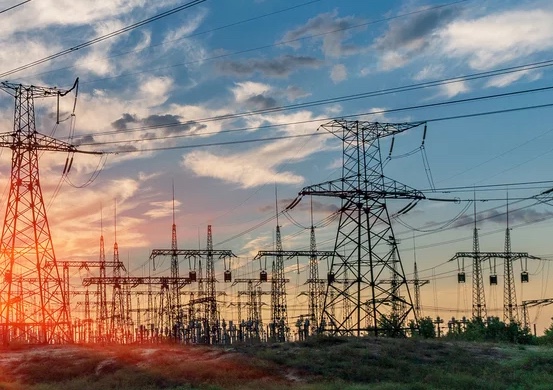
Battery energy storage is a critical technology to reducing our dependence on fossil fuels and build a low carbon future. Renewable energy generation is fundamentally different from traditional fossil fuel energy generation in that energy cannot be p....
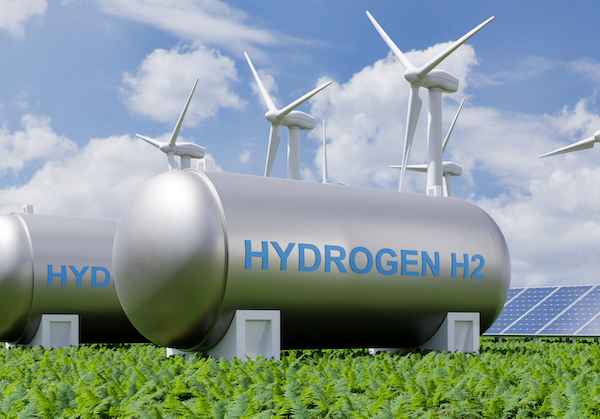
Not enough people know that hydrogen fuel cells are a zero-emission energy technology. Even fewer know water vapor's outsized role in electrochemical processes and reactions. Producing electricity through a clean electrochemical process with water....

In the ever-evolving landscape of sustainable transportation, a ground-breaking shift is here: 2024 ushers in a revolutionary change in Electric Vehicle (EV) tax credits in the United States. Under the Inflation Reduction Act (IRA), a transforma....

Now more than ever, it would be difficult to overstate the importance of the renewable energy industry. Indeed, it seems that few other industries depend as heavily on constant and rapid innovation. This industry, however, is somewhat unique in its e....

University of Toronto’s latest student residence welcomes the future of living with spaces that are warmed by laptops and shower water. In September 2023, one of North America’s largest residential passive homes, Harmony Commons, located....
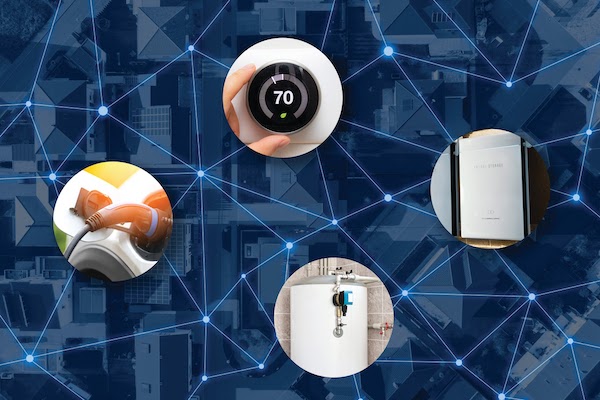
For decades, demand response (DR) has proven a tried-and-true conservation tactic to mitigate energy usage during peak demand hours. Historically, those peak demand hours were relatively predictable, with increases in demand paralleling commuter and ....